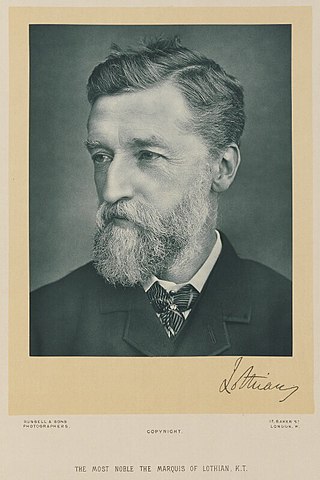Related Research Articles

Marquess of Zetland is a title in the Peerage of the United Kingdom. It was created on 22 August 1892 for the former Lord Lieutenant of Ireland, Lawrence Dundas, 3rd Earl of Zetland. Zetland is an archaic form of Shetland. The Dundas family descends from the wealthy Scottish businessman and Member of Parliament, Lawrence Dundas. In 1762 he was created a Baronet, of Kerse in the County of Linlithgow, in the Baronetage of Great Britain. The title was created with remainder, failing heirs male of his own, to his brother Thomas Dundas and the heirs male of his body. He was succeeded by his son, the second Baronet. He represented Richmond and Stirling in the House of Commons and also served as Lord Lieutenant of Orkney and Shetland. In 1794 he was created Baron Dundas, of Aske in the North Riding of the County of York, in the Peerage of Great Britain. Lord Dundas notably purchased the right to the earldom of Orkney and lordship of Zetland from James Douglas, 14th Earl of Morton.

Thomas Laurence Dundas, 1st Baron Dundas, FRS was a Scottish politician and peer who sat in the British House of Commons from 1763 to 1794 when he was raised to the peerage of Great Britain as Baron Dundas. He was responsible for commissioning the Charlotte Dundas, the world's "first practical steamboat".

Lawrence Dundas, 1st Marquess of Zetland,, known as Lawrence Dundas until 1873 and as The Earl of Zetland from 1873 to 1892, was a British hereditary peer and Conservative statesman. He was Lord Lieutenant of Ireland between 1889 and 1892.

This is a list of people who have served as Lord Lieutenant of Nottinghamshire. Since 1694, all Lords Lieutenant have also been Custos Rotulorum of Nottinghamshire.
This is a list of people who have served as Lord Lieutenant of Midlothian.

Schomberg Henry Kerr, 9th Marquess of Lothian,, styled Lord Schomberg Kerr until 1870, was a British diplomat and Conservative politician. He served as Secretary for Scotland under Lord Salisbury between 1887 and 1892. He was usually styled simply as Lothian.
This is a list of people who have served as lord-lieutenant for Berwickshire.
This is a list of people who served as Lord Lieutenant of Lanarkshire.

William Frederick Waldegrave, 9th Earl Waldegrave, VD, PC, styled Viscount Chewton between 1854 and 1859, was a British Conservative politician. He served as Captain of the Yeomen of the Guard, government chief whip in the House of Lords, between 1896 and 1905.
The Hon. John Charles Dundas, was a British Liberal politician.
John Dundas may refer to:
The royal households of the United Kingdom consist of royal officials and the supporting staff of the British royal family, as well as the royal household which supports the sovereign. Each member of the royal family who undertakes public duties has their own separate household.
Sir William Honyman, 1st Baronet, also known by his judicial title Lord Armadale, was a Scottish landowner, and judge from Orkney. On his lands in Sutherland he was one of the first landlords to evict tenants in order to create sheep farms, a process which grew to become the Highland Clearances.
Admiral Robert Honyman was a Scottish admiral in the British Royal Navy who served in the French Revolutionary Wars and in the Napoleonic Wars. A native of Orkney, he also held office for ten years as a member of parliament (MP) for Orkney and Shetland.
Hon. Charles Lawrence Dundas was a British politician and Whig Member of Parliament in the House of Commons. He represented Malton from 1798–1805 and Richmond from 1806 to his death.
References
- Sainty, J. C. "Lieutenants and Lord-Lieutenants of Counties (Scotland) 1794-" . Retrieved 10 February 2018.
- 1 2 "Morton, Earl of (S, 1457/8)". Archived from the original on 27 June 2010. Retrieved 13 February 2011.
- 1 2 3 4 5 6 Joseph Haydn and Horace Ockerby, The Book of Dignities, London 1894, p. 511
- ↑ "No. 13652". The London Gazette . 6 May 1794. p. 409.
- ↑ "No. 27156". The London Gazette . 23 January 1900. p. 438.